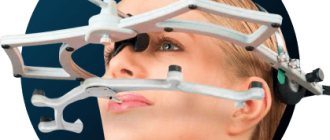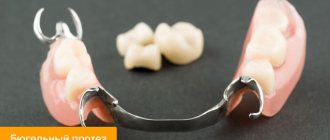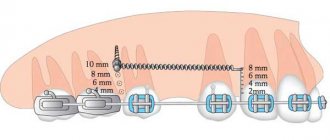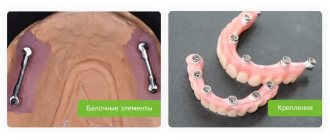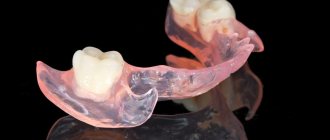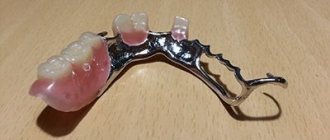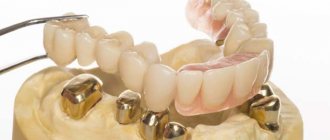There are many methods for restoring teeth in dentistry. Each of them has its advantages and helps solve a specific problem. However, implant prosthetics are considered the most effective.
The basis of the method is the implantation of titanium pins into the jawbone, which replace the roots of natural teeth. An orthopedic structure is installed on top of the pin, depending on the condition of the dentition.
The technology is applicable to restore one tooth, several dental units in a row, or the entire jaw at once. In the first case, an artificial crown is fixed on the implant, a bridge structure is used to replace 2-3 teeth, and when all teeth are restored, a fixed or removable prosthesis is used. The doctor selects the material for the orthopedic design based on the method of installing the prosthesis, the preferences and financial capabilities of the patient.
Pros of technology
Some will say that dental implantation is very expensive. But if you evaluate the result in perspective, it turns out that this is a profitable investment in your own health for the next 20-25 years.
Judge for yourself: the service life of prostheses on implants is 2-3 times longer than traditional designs. And the titanium pin ensures an even load on the jaw, while maintaining chewing and speech functions.
In addition, the use of implants when installing dentures allows you to restore any number of teeth, regardless of their location in the oral cavity.
In case of edentia (complete absence of teeth), implants can be used to place not only a removable, but also a permanent orthopedic structure, which in its properties is much more convenient and reliable.
Uniform load on the jaw eliminates bone tissue atrophy and subsequent problems with natural teeth. In addition, implant prosthetics do not use healthy teeth. Nothing is attached to them; natural teeth do not need to be ground down, which significantly extends their life.
Dentures are comfortable to wear: they do not injure the gums, do not distort diction, and do not shift under load.
But the main advantage is the high level of aesthetics. All types of dentures installed on implants look like real teeth.
Patient reviews
Most people who have installed removable structures on implants admire their superiority compared to conventional removable devices and their affordable price. Such dentures will not fall out during lunch or a business meeting.
But at the same time, patients note the fragility of the products, since after 2-3 years their quality begins to deteriorate, which causes psychological and physical discomfort.
It should be noted that the success of implantation is influenced by various factors, among which the doctor’s professionalism plays a central role. At the Uni Dent dental clinic, only qualified, experienced doctors practice with extensive knowledge in their field and the necessary skills, which guarantees a high-quality result.
Types of structures
In general, implant-supported prostheses are divided into two types:
- Removable.
- Fixed.
The first type differs significantly from analogues of classical prosthetics. Traditional structures are fixed exclusively on the gums, or attached to supporting teeth. Thanks to implants, removable dentures are securely fixed in the jawbone, but they can be removed if necessary. That's why they are called conditionally removable.
Fixed dentures are considered a more durable and optimal option for dental restoration. In addition to the artificial crown, some types of structures are equipped with a base made of elastic plastic, which imitates natural gums.
Fixed dentures can be used to replace any number of teeth, even if they are located in different parts of the dentition. We will talk in more detail about each type of prosthesis a little later.
There are also temporary dentures that are installed during the period of fusion of the implants with the jawbone. They maintain the aesthetics of the dentition and reduce the mechanical load on the pins, speeding up the healing process.
Temporary dentures look like removable structures that hook onto supporting healthy teeth using hooks. The most common option is a butterfly-shaped prosthesis. It is equipped with a plastic gum and two plastic holders for adjacent teeth. A denture replaces one or more teeth in a row.
What is a dental implant?
This is a device fixed into the bone tissue of the jaw and replaces a fallen or initially missing tooth. Dental implants support crowns, bridges of various lengths, removable and fixed dentures.
Several types of implants are used in dentistry, but the most widespread are root-shaped implants. These are structures consisting of a metal rod implanted into the jaw tissue and an abutment - an artificial tooth that is ground into a crown. If necessary, a gum former is installed on the implant shaft - a special metal screw with a cap. It is attached to the implant before installing the abutment and forms the gum relief to achieve an aesthetic result.
Root-shaped implants are cylindrical and screw with thread. The latter are more common, since due to the thread, the implant fuses more firmly with the jaw tissue.
Installation steps
The reliability of implant-supported dentures directly depends on the location of fixation. Especially when it comes to restoring all teeth. Correct placement of implants will ensure uniform distribution of chewing load on the jaw and allow the use of a minimum number of pins. This reduces the recovery period and the degree of surgical intervention during installation.
At the initial stage, the implantologist performs an initial examination of the oral cavity. In EspaDent clinics, to select a prosthetic method, additional diagnostics are carried out using a modern Orthophos SL 3D tomograph, which takes three-dimensional, layer-by-layer images of both jaws. Professional equipment allows you to simulate the treatment process and show the patient the final result.
In the absence of contraindications, the doctor proceeds to the next stage of prosthetics on implants - fixation of titanium pins in the jawbone. The procedure takes 40-60 minutes for each implant. It is carried out using anesthesia. Our specialists use safe painkillers. They are non-toxic and do not cause allergic reactions.
The pin fixation process includes:
- Gum section.
- Preparing the space in the jawbone.
- Implant installation.
- Gum stitching.
The period of fusion of the pin with the bone tissue takes 3-4 months. During this time, the patient is fitted with temporary removable dentures, which we discussed above.
After the healing process is completed, the doctor installs a gum former and takes an impression of the teeth. After a couple of days, the adapter is replaced with an abutment, on which the finished denture is fixed.
How long does prosthetics take?
The duration of installation of prostheses on implants depends on the clinical situation. After performing a tomography of the jaw, the doctor assesses the condition of the bone tissue. Depending on the degree of jawbone atrophy, the implantologist may prescribe an osteoplasty procedure.
The period of prosthetics on implants is determined by the rate of bone tissue regeneration, as well as the chosen installation technique. For example, the healing period of implants in the upper jaw takes, on average, 3-4 months. For the lower jaw a little less - 2-3 months.
If a procedure is carried out to restore bone tissue due to atrophy, then another 2-4 weeks are added to the installation of prostheses.
How many artificial roots are needed?
Theoretically, two titanium rods are enough to secure the removable system. In this case, it is possible to significantly reduce the cost of treatment, but at the same time the performance properties of removable appliances are significantly deteriorated: the fastenings become loose, the structures do not fit tightly to the gum (it often atrophies) and are displaced. As a result, the aesthetics of the smile deteriorate, discomfort and pain arise, and you have to give up solid food. Therefore, dentists recommend screwing four screws into the lower jaw, and six into the upper jaw.
Prosthetics using removable structures
When is it advisable to use removable dentures on implants? Often the argument is limited budget. Removable structures are much cheaper than permanent ones, especially in the case of complete edentia.
The method is effective for severe atrophy of the jaw bone, if the patient is not ready to undergo a sinus lift of the jaw. A denture with artificial gum will hide imperfections in the contour of your own tissues.
Conditionally removable structures are fixed to implants in two ways: screw or beam. In the second case, a metal structure in the form of a beam is used, on which artificial teeth are installed. The beam serves as the base of the prosthesis and ensures uniform distribution of mechanical load on the bone. Due to the single design, the prosthesis is more stable.
Both options for fixing the prosthesis can be removed if necessary (for cleaning, etc.). However, only a dentist should do this.
What is the difference between classic removable dentures and those installed on implants? The design with pins is smaller in size and has better fixation in the oral cavity, which ensures comfortable wearing.
The absence of a palate in the prosthesis preserves taste sensitivity when eating food, without any restrictions.
The ability to remove the prosthesis extends its service life and allows for timely cleaning and replacement of elements, if necessary.
Lower cost makes this type of implant prosthetics accessible to most patients.
If we talk about size, fixed dentures are more neat and compact. From an aesthetic point of view, removable ones are also inferior to non-removable ones. The latter do not have artificial gums.
To make crowns in removable dentures, the following is used:
- Plastic (for temporary fixation).
- Ceramics.
- Zirconium dioxide.
All materials have increased strength and high aesthetics. At EspaDent clinics, crowns are made using digital CAD/CAM technology. The automatic production mode eliminates the occurrence of errors associated with the human factor. Dentures take into account the anatomical structure of the patient’s jaw and the location of adjacent teeth. Their installation does not change the bite, does not deform the masticatory muscles, and does not cause facial asymmetry.
How is a denture attached to the mouth?
Two methods can be used to attach clasp prostheses to implants:
- Beam - several implants are connected to each other by a metal beam. The second part of such fastening is fixed on the prosthesis. When two metals are connected, a reliable fastening is obtained, which contributes to the long service life of the product.
- Through attachments. This mount also has 2 parts. One part of the fastening in the form of a ball is installed in the implant, the second in the form of a cavity to the size of the ball is located on the structure. This method of fastening will require less expense, but products with such fastening will last less than with beam fastening.
Both of these types of fastenings can be replaced. If the structure is damaged, it can be replaced with any other prosthesis without affecting the implants.
Fixed structures
As a rule, crowns or bridges are used for fixed prosthetics on implants. A single denture most accurately replicates the shape and appearance of the missing tooth. Using single crowns, the implantologist corrects the gum contour, making it almost ideal. This is especially true for the front teeth that fall into the smile zone.
A bridge structure is used to restore several teeth. It is necessary in cases where it is not possible to install 2-3 implants in a row due to lack of space.
The difference from a traditional bridge lies in the method of fastening. The structure receives additional support in the form of pins and does not affect adjacent healthy teeth. In other words, there is no need to grind down your natural teeth and attach a prosthesis to them.
The advantages of the technique include the maximum degree of stabilization of the prosthesis, high aesthetics and a tight fit of the structure to the gum, which eliminates its damage and the ingress of food debris into the prosthesis.
The only disadvantage of fixed dentures on implants is the price. But in fact, this is the most profitable investment in your own health. The durability of the implants and the lifetime guarantee for their installation only confirms the quality of the technique.
Cost of biotechnological clasp
The price of a biotechnological clasp prosthesis is 297,000 rubles.
Payment in installments is possible:
The first installment is 97,000 rubles, then 24 months of 9,000 rubles.
Included in the price:
- biotechnological clasp prosthesis made of thermopolymer material.
- 2 mini implants with spherical attachments
- 2 locks for spherical implants
- 2 spare dies
- bloodless installation of mini-implants using a surgical template.
- 3D modeling
The price does not include:
- initial consultation with a specialist
- surgical template
- additional mini implants, at the request of the patient.
IN THE PHOTO: PROSTHETICS USING BIOTECHNOLOGICAL BUGEL PROSTHETICS
Restoration of teeth with complete edentia
The method of fixed prosthetics effectively copes with the problem of complete absence of teeth. For example, All-on-4, All-on-6 protocols or simultaneous implantation.
The All-on-4 protocol involves the installation of four implants in the jaw: two in the frontal part, two on the sides, at an angle to the jaw.
The technology provides instant chewing load, immediately after fixing the prosthesis. Installation of the prosthesis is possible immediately after implantation.
If the patient has severe jawbone atrophy, the All-on-6 protocol is used. An additional number of implants ensures reliable fixation of the prosthesis even with insufficient bone tissue.
But be careful! Due to the popularity of the technology, many fakes have appeared. Poor quality materials and unprofessional work can lead to serious health complications and loss of money.
EspaDent is an official partner of Nobel Biocare, a leader in implantology and developer of protocols for dental restoration in 1 day.
In 2016, with the support of Nobel Biocare, our clinic created its own Implantation Center, which provides training to specialists from all regions of Russia.
Materials for dentures
To attach prostheses to implants, the material must be highly durable or have a metal base. This is necessary for the structure to withstand the load of the abutment (adapter).
Crowns for fixed structures are made from metal-ceramics, composite, metal-plastic, and also from zirconium dioxide. The prosthesis is attached using cement or screws.
Composite crowns with a metal frame are used for single replacements, as well as for the installation of bridges. The design has a long service life (10-12 years) and is subject to repair. Reliable, lightweight, with a high degree of aesthetics, composite crowns are comfortable to wear and look like real teeth.
Plastic removable dentures last no more than 5 years and are used only for temporary or adaptive prosthetics. At EspaDent clinics, our specialists use more technologically advanced plastic for temporary prostheses. The composition contains crushed diamond chips, which makes the structure more resistant to stress during the fusion of the implant with the bone.
Fixed prosthesis is made of zirconium or metal ceramics. This is due to the high reliability of the design. Crowns cannot be restored, as is the case with composite crowns, so they must be as strong and durable as possible. For metal-ceramics, the service life is 8-10 years, and zirconium is a little longer - 15-17 years.
The disadvantages include the imperfect aesthetics of ceramic crowns - the metal base can be visible in the light. Therefore, it is better to use them to restore lateral teeth.
Zirconium dioxide crowns have almost no disadvantages. Decent service life, impeccable appearance, increased material strength, absence of allergic reactions even in patients with high sensitivity. Of course, such prostheses are more expensive than their analogues.
Contraindications
It is obvious that implant prosthetics is a complex and expensive procedure. Therefore, even at the initial stage, it is important to eliminate all possible risks for the patient.
The reason for refusal or delayed treatment may be jaw deformation, pathological atrophy of bone tissue, bruxism, increased tooth wear, and malocclusion. Contraindications to surgery are also diseases of the nervous system, bleeding disorders, reduced immunity, intolerance to painkillers, and the presence of tumors.
Advantages of dentures on implants
The fact is that the bone tissue of our jaw retains its volume only if it is under constant load, which is provided by a natural tooth (to a greater extent its root) or a titanium implant. A conventional denture comes into contact only with soft tissue or rests on the remaining living teeth, so the bone tissue in this area atrophies. This threatens several serious consequences at once, including displacement of the dentition, disruption of facial symmetry, overload of the jaw joint, as well as faster destruction of the supporting teeth and the dentures themselves. Of course, there are situations when it is possible to restore chewing function and aesthetics only with the help of classical dentures, but if you have no contraindications to implantation, we strongly recommend that you turn to this method.
Advantages:
- all dentures are installed with support from implants and do not require grinding of healthy teeth;
- with proper care, implants can last a lifetime, and prosthetic elements can be replaced over the years;
- the ability to chew without pain and the food you want - with virtually no restrictions;
- high aesthetics and functionality.
Care instructions
In order for implant-supported dentures to last as long as possible, they require careful care. Each patient receives written information about how to care for fixed or removable dentures after the procedure.
Special toothpastes and brushes are used to clean dentures. It is easier to take care of removable structures, because... You can easily remove the prosthesis. For this purpose, it is recommended to visit the dentist's office, who will professionally clean the dentures.
To remove food debris from interdental crevices and hard-to-reach places in the structure, you need to use dental floss, brushes and irrigators.
Remember, proper care of the prosthesis and careful use significantly extends its service life.
How to care for orthopedic systems
Hygienic maintenance of removable devices on implants is easier compared to conventional removable dentures. They are not removed daily, but only once a month. Cleaning is carried out twice a day. In this case, you should clean not only the artificial teeth, but also the acrylic base. Particular attention is paid to areas adjacent to the mucous membrane and interdental spaces. It is best to use an irrigator, which, unlike a brush, efficiently removes dental plaque from hard-to-reach places. After eating, rinse the mouth with special means.
Timely preventive examinations are important for maintaining the freshness, whiteness and aesthetics of teeth. Uni Dent dental specialists will promptly identify and eliminate inflammatory processes that can cause implant rejection and other pathological changes in the oral cavity.
